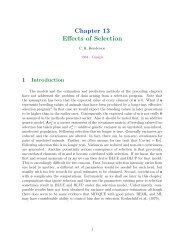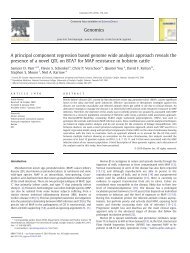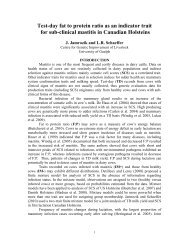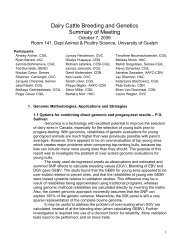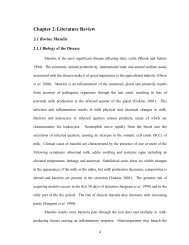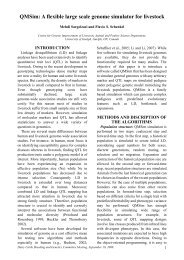Analysis of Bull Proofs for Intermediate Optimum Traits - CGIL
Analysis of Bull Proofs for Intermediate Optimum Traits - CGIL
Analysis of Bull Proofs for Intermediate Optimum Traits - CGIL
You also want an ePaper? Increase the reach of your titles
YUMPU automatically turns print PDFs into web optimized ePapers that Google loves.
sire’s pro<strong>of</strong> on the desirability scale could be examined. The underlying hypothesis <strong>of</strong> this<br />
approach is that the publication <strong>of</strong> pro<strong>of</strong>s on the tendency scale alone would suffice if bulls with<br />
pro<strong>of</strong>s near the breed average showed a consistently desirable pattern <strong>for</strong> producing desirable<br />
daughters.<br />
Results & Discussion<br />
<strong>Bull</strong> pro<strong>of</strong>s aim to reflect the expected average per<strong>for</strong>mance <strong>of</strong> future daughters assuming a<br />
continuous linear scale. For type traits with an intermediate optimum that are recorded on a 9point<br />
linear scale, previous research found various bulls to have desirable daughter averages<br />
near the optimum score <strong>of</strong> 5 based mainly on daughters at each extreme <strong>of</strong> the linear scale<br />
rather than a majority at the ideal mid-score value. Computing genetic evaluations using these<br />
data yield bull pro<strong>of</strong>s near the ideal <strong>of</strong> zero (meaning no clear tendency towards either extreme)<br />
and there<strong>for</strong>e suggest these bulls are breed improvers. For these reason, in 1997, it was<br />
decided to use the same classification data, but on a folded scale <strong>of</strong> 1 to 5, to produce genetic<br />
evaluations on a desirability scale, published as Set <strong>of</strong> Rear Legs and Pin Setting.<br />
Figures 1 and 2 show a clear relationship between the percentage <strong>of</strong> daughters that have an<br />
ideal score <strong>of</strong> 5 and the sire’s pro<strong>of</strong> <strong>for</strong> Set <strong>of</strong> Rear Legs and Pin Setting, respectively, based on<br />
bulls that have a pro<strong>of</strong> on the tendency scale that is near breed average. Daughters <strong>of</strong> bulls<br />
that are close to average <strong>for</strong> Rear Leg Side View and have a Set <strong>of</strong> Rear Legs pro<strong>of</strong> <strong>of</strong> less than<br />
-10 have about a 20% probability <strong>of</strong> having an ideal score <strong>of</strong> ‘5’ <strong>for</strong> Rear Leg Side View. In<br />
contrast, daughters <strong>of</strong> bulls with an average pro<strong>of</strong> <strong>for</strong> Rear Leg Side View and are at least +10<br />
<strong>for</strong> Set <strong>of</strong> Rear Legs have more than 40% chance <strong>of</strong> having a score <strong>of</strong> 5. Similar results were<br />
observed <strong>for</strong> Rump Angle/Pin Setting in Figure 2 with the spread in likelihood <strong>of</strong> having an ideal<br />
daughter being from 30% at -10 to 50% at +10 <strong>for</strong> Pin Setting.<br />
The standard deviation <strong>of</strong> daughter scores <strong>for</strong> bulls at opposite ends in their pro<strong>of</strong> <strong>for</strong> Set <strong>of</strong><br />
Rear Legs (and Pin Setting) also has a clear trend based on bulls that have a pro<strong>of</strong> near breed<br />
average <strong>for</strong> the pro<strong>of</strong> on the tendency scale. Basically, a higher standard deviation <strong>of</strong> daughter<br />
scores <strong>for</strong> negative pro<strong>of</strong>s on the desirability scale reflect that these bulls have a large variation<br />
in how their daughters are scoring. Less variability in daughter scores <strong>for</strong> highly rated bulls on<br />
the desirability scale indicate that the system is appropriately identifying bulls that are producing<br />
daughters that consistently have the ideal phenotype.<br />
Conclusion and Recommendation<br />
The results <strong>of</strong> this analysis, as presented in Figures 1 and 2, clearly show that there are bulls<br />
evaluated as ideal (i.e.: near zero) on the tendency scale that are inappropriately considered as<br />
siring daughters near the ideal rating <strong>of</strong> 5. There<strong>for</strong>e, the pro<strong>of</strong> in<strong>for</strong>mation on both the<br />
tendency and desirability scales are required <strong>for</strong> a proper interpretation <strong>of</strong> bull pro<strong>of</strong>s <strong>for</strong> these<br />
intermediate optimum type traits. While this analysis was done only <strong>for</strong> the Holstein breed there<br />
is no reason to assume that a similar result would not also occur <strong>for</strong> other breeds. It is<br />
recommended that the current procedure <strong>for</strong> calculating pro<strong>of</strong>s on both the tendency and<br />
desirability scales be continued.





